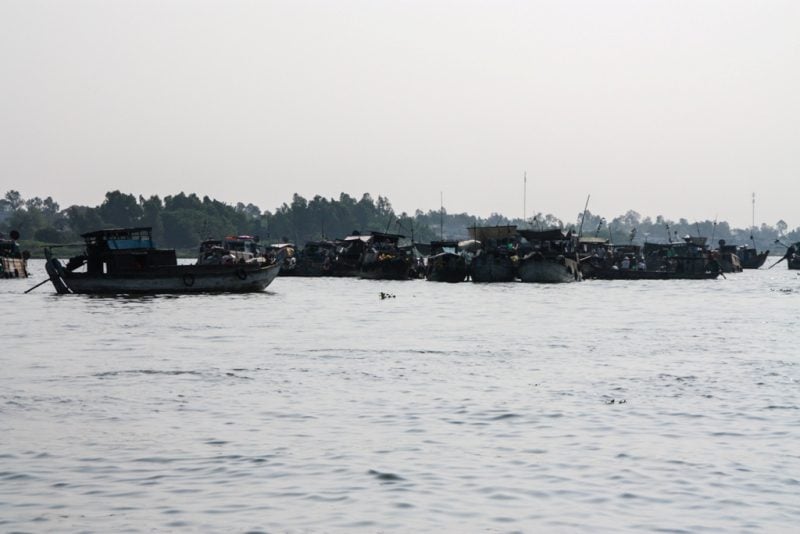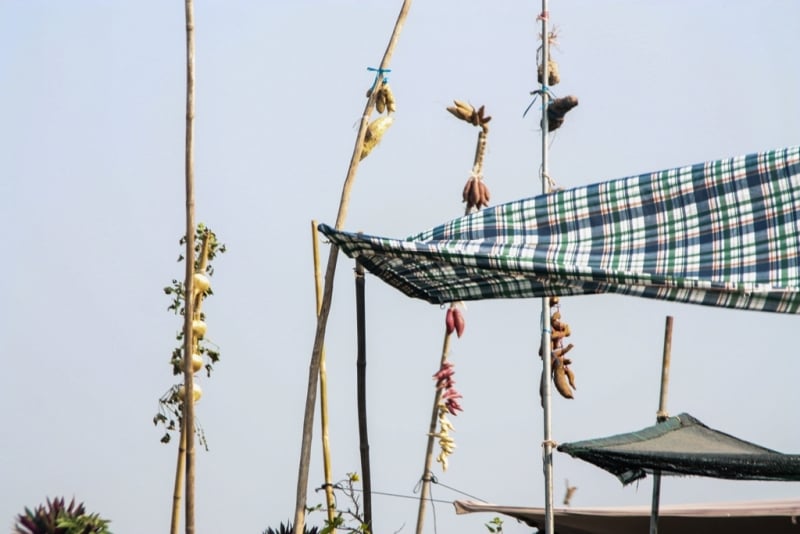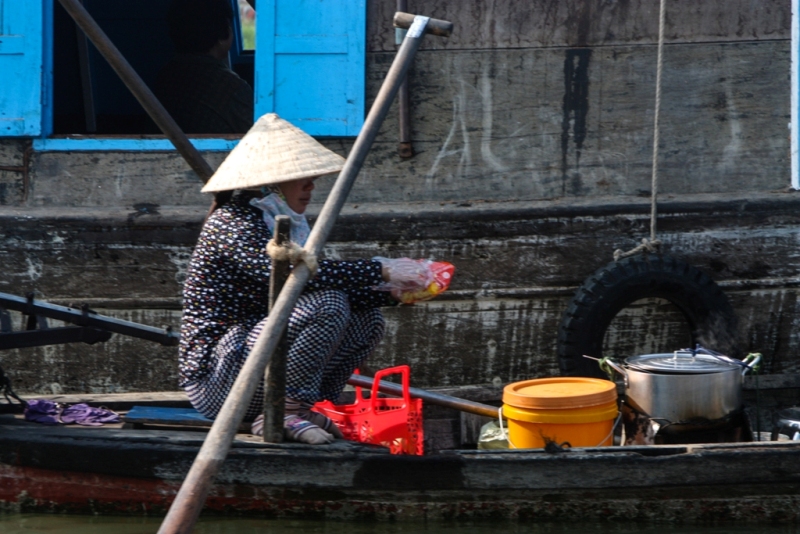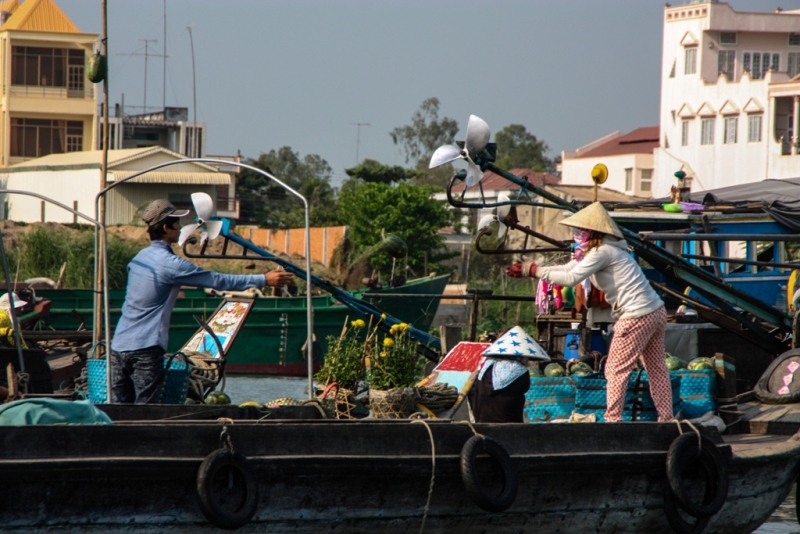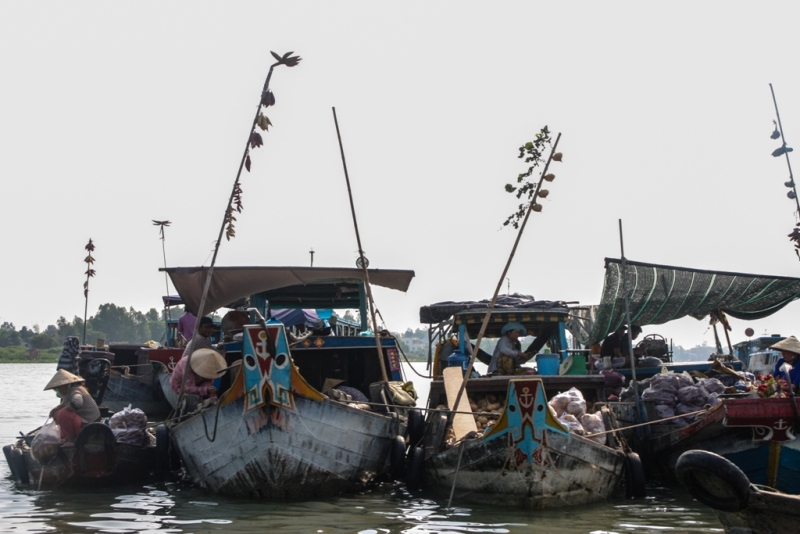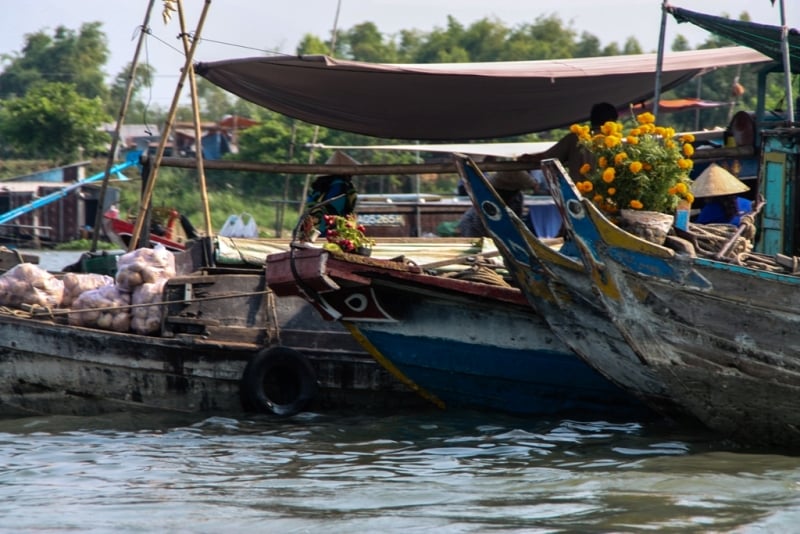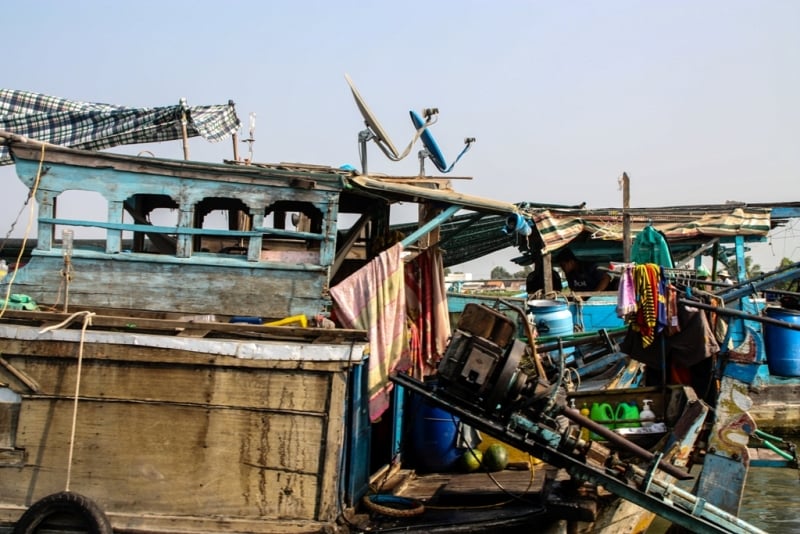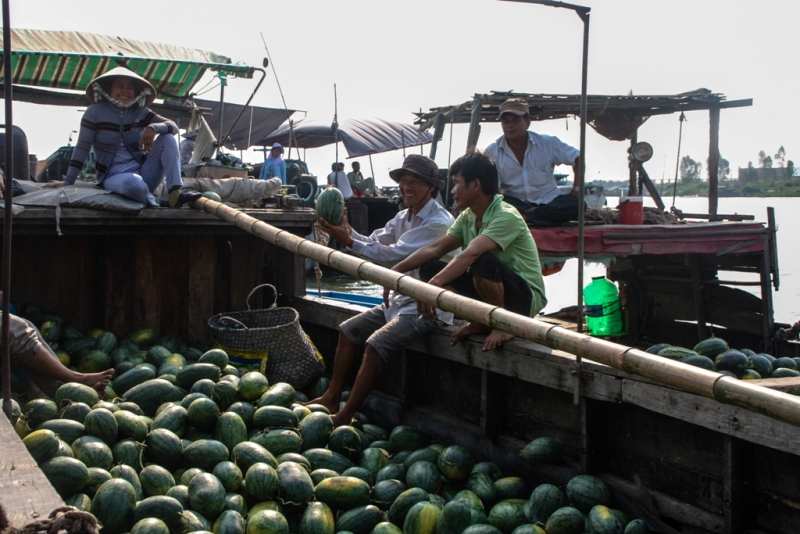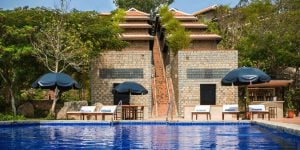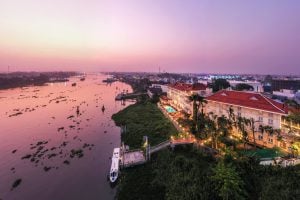While not as large as the Cai Be Floating Market near Can Tho, the Chau Doc Floating Market is vibrant, colorful and beautiful to photograph.
Just past where the Chau Doc River merges into the Hau River, about 30 boats congregate in the early morning hours. In a region with a vast network of waterways, large and small, having a market on the water simply makes sense.
These barges come from all over the Mekong Delta, laden with a variety of fruits and vegetables. Don’t expect to see meat or leafy greens, though, as the market features products that don’t spoil easily. While many say there’s less haggling in the floating market than in a land-based one, they’re also much quieter. No one needs to hawk their goods, as they’re conveniently displayed on long poles for everyone to see.
The market typically starts early, reaching its peak at around 6-7am and tapering until noon. Most of the customers are re-sellers, smaller boats who come and buy goods to then either sell themselves at the market or to supply smaller markets.
That said, because so many people live on the water’s edge, for some, it’s just as convenient to hop on a boat and shop at the floating market.
From a photographer’s point of view, the Chau Doc Floating Market has so many angles, colors and subjects that it’s a pleasure to shoot. Here are some tips for capturing amazing photos from this unique event.
Find the Right Boat and Guide
The floating market is in the middle of the wide Hau River which means you’ll need to visit it from a boat to see it in any detail. While there are boats for hire from the Chau Doc promenade next to the Victoria Chau Doc Hotel, these boats tend to be small, without room to maneuver. That means you’re basically locked in to one shooting position. As well, the driver likely will speak no English, so it’ll be difficult to communicate what kind of angle you’re looking for.
Using a larger boat that’s still river-level (as opposed to the larger two-story cruise boats), provides the best vantage point for photography as you’re able to move about the boat, from side to side and front to back.
Being able to move around the boat means you’ll have more options for backgrounds. Setting a subject against a solid background helps to train the viewer’s focus where you want, as in this image of a mobile noodle seller against the plain background of one of the barges where a bright blue window provides a pop of color.
Being able to reposition yourself also means being able to avoid busy backgrounds that may obscure your subject, like in this image of two people tossing watermelons. Unfortunately the greenery in the background completely camouflages the green watermelon being tossed mid-air, turning a potentially interesting image into a mundane one. (Look closely and you’ll see the watermelon right in the center of the bush.) The boats are often piled high with produce which means tossing things from one place to another is the only way to move them!
While shooting, also look at how capturing the same or similar subjects from different angles helps to tell different stories.
Head on, this image shows off the various sizes of the boats and how closely they’re moored together. Like many seamen around the world who work around the dangers inherent to water, whether it be open ocean or rivers and lakes, the Vietnamese sailors have numerous superstitions. Here, you can spot the “eyes”, a distinctive feature of Vietnamese boats, believed to ward off evil spirits or monsters, and to also guide the boats away from danger and safely back home.
Capturing the boats from the side highlights an aesthetically pleasing pattern of just the bows. The potted plants that provide a touch of home are just a bonus.
The same can be said from photographing just the backs of the boats, propellers in the air and satellite dishes on the roofs, to break up what would otherwise be a continuous shape.
Shooting the boats from the back illustrates how cramped the quarters really are with all the gear needed to be able to live on the boats for days at a time.
When out on the water, ask the driver to make a couple of rounds of the boats so that you’re able to shoot them from various angles and don’t forget to move around to achieve the best views.
Think About Composition
The “Rule of Thirds” in photography refers to placing important elements in specific parts of the frame. Imagine dividing your image into an even 3 x 3 grid created by two equally spaced horizontal lines and two equally spaced vertical lines. Placing your subject along these lines or their intersections creates a more pleasing effect than when subjects are simply centered.
In this image of a watermelon barge, the watermelons take up the bottom third, the people the middle third and the sky the top third.
The next two images also illustrate how the Rule of Thirds comes into play with two subjects that are very similar. Which one do you like better?
While both are quite similar, in the first image, the subject is placed at the lower right quadrant and the horizon is two-thirds of the way down whereas in the second image, both the subject and the horizon are centered, making the image less appealing.
The Chau Doc Floating Market is a fantastic place to practice your photography skills with a wide variety of subjects, both still and moving. For those not particularly interested in photography, the time-old watery market is still a feast for the eyes.
See Part 2 where we use the Chau Doc Floating Market as a background to talk about shutter speeds, looking for details, zooming in on subjects and taking photos that tell a story.
If you go: There are small boats for hire from the Chau Doc promenade next to the Victoria Chau Doc Hotel. Prices are negotiable depending on what you want to see and how long you want to be out on the water. Do not expect the drivers to speak much English. Do expect to haggle on pricing.
Alternatively, the Victoria Chau Doc Hotel offers a river tour that includes visiting the floating market as well as a floating fish farm and other river-based sights. Boats are large which means you’ll be able to reposition yourself for optimal angles, and there is a small deck with unobstructed views in the back of the boat. River excursions can be booked at the tour desk at Victoria Chau Doc or by emailing: [email protected]
